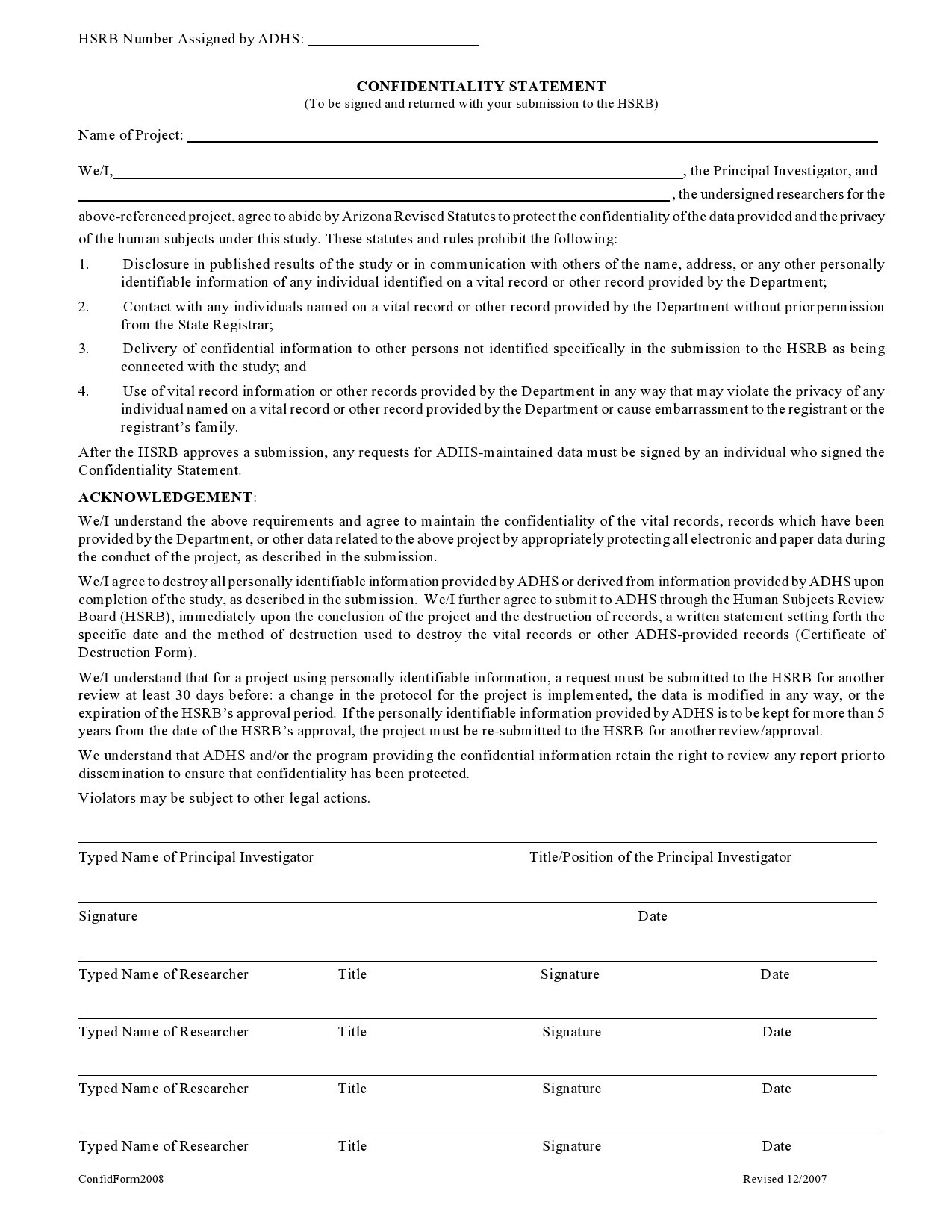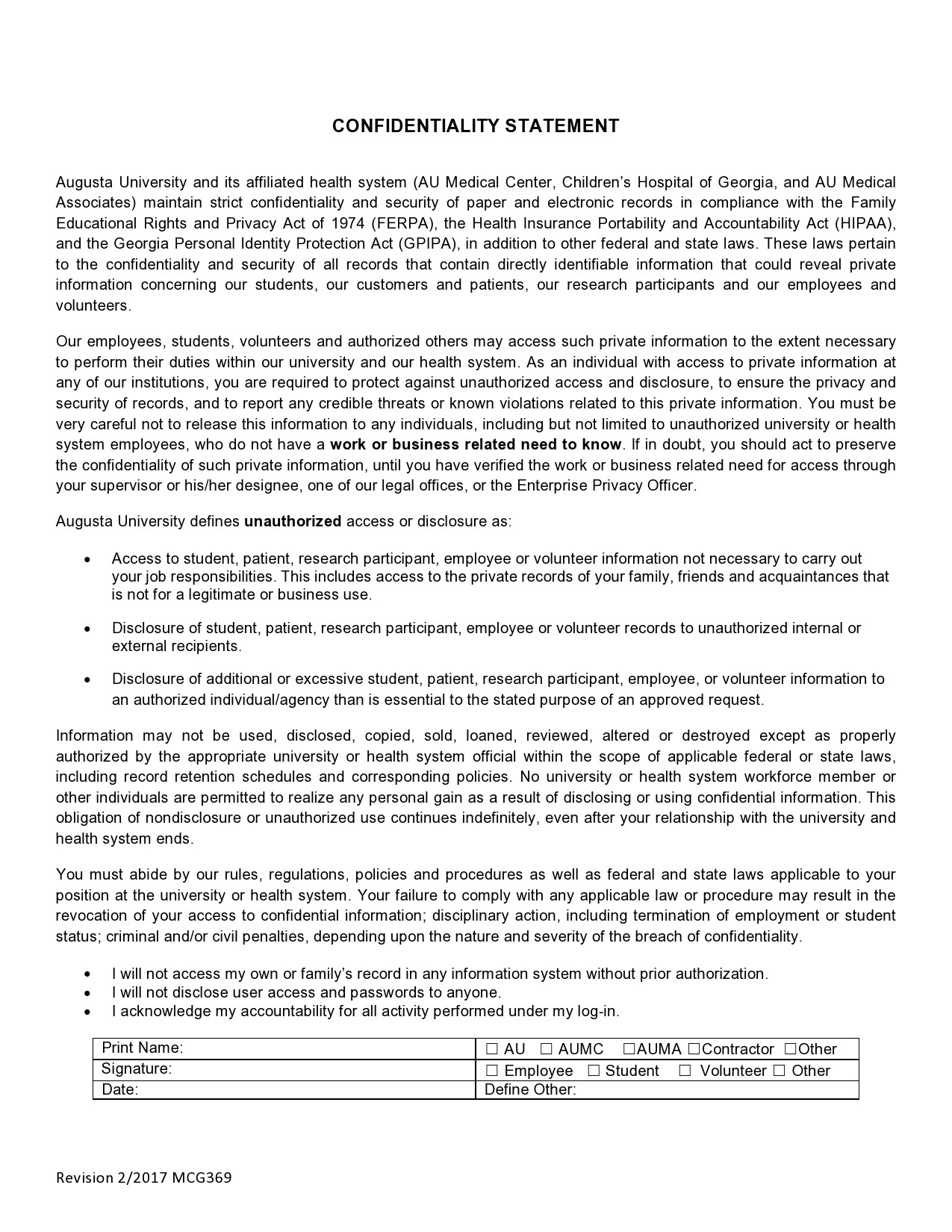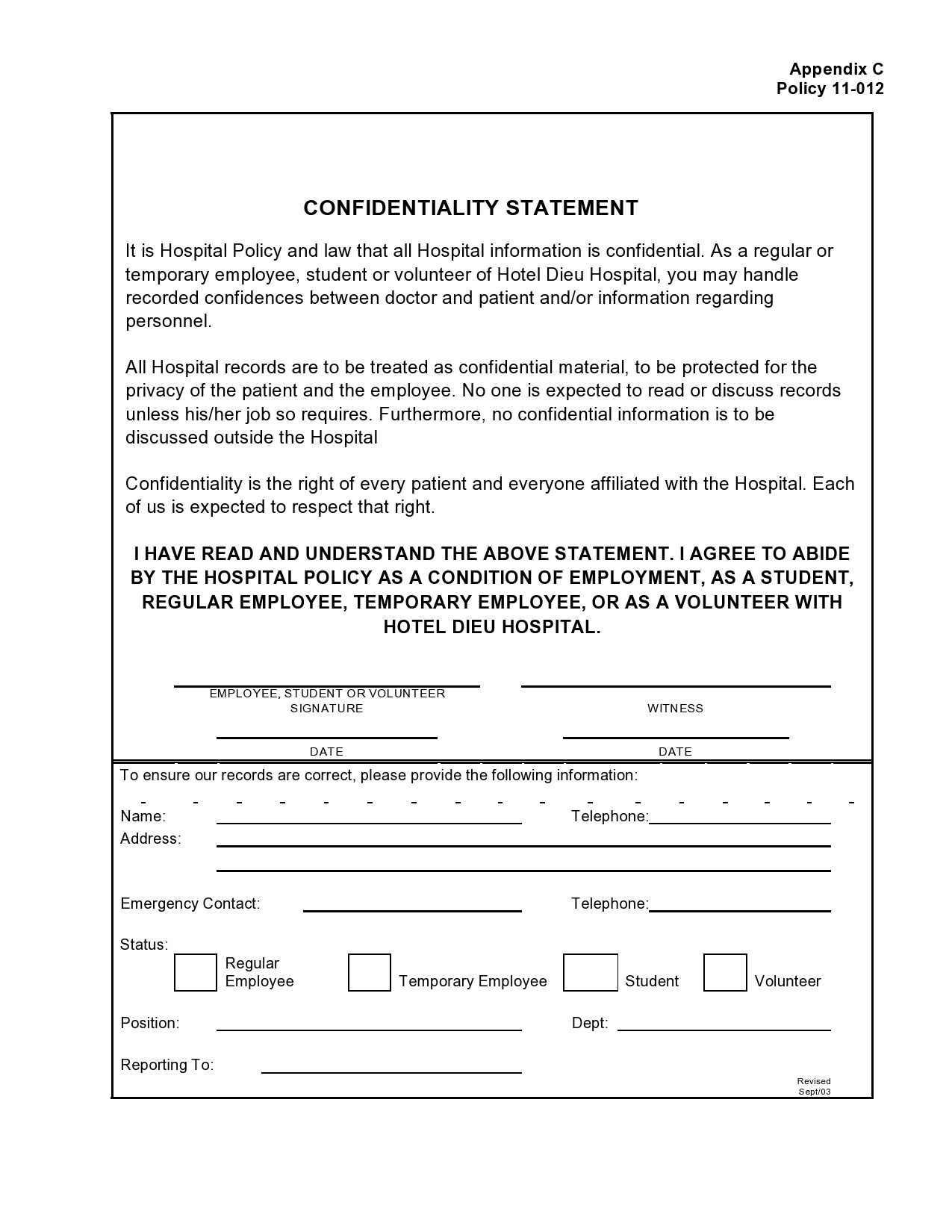If you are planning to write a confidentiality agreement template, you need to look at some confidentiality statement examples or an email confidentiality statement to be sure that the formatting of this letter is correct. You will also want to be sure that you are aware of what needs to be included in confidential statements for documents and what a standard confidentiality agreement form has to say to be legally binding. Confidential agreement forms can be critical for a variety of business and personal needs, but this document can only be effective if it has been drafted in the right way and includes the right language.
Use of this kind of document is often necessary if you want to keep specific information from being disclosed for a set period of time. The time frame for these documents can vary, but the stated duration of the relationship between the two parties is usually what limits the contract duration. If you have the need for this kind of documentation to protect information from being disclosed, you need to be sure that you know how to create a correct confidentiality agreement.
Table of Contents
- 1 Confidentiality Statements
- 2 What is a standard confidentiality agreement?
- 3 What is an example of confidentiality?
- 4 When is a confidentiality agreement used?
- 5 Confidentiality Statement Examples
- 6 What is a confidentiality disclaimer?
- 7 How do I write a confidentiality agreement?
- 8 Confidentiality Agreement Templates
- 9 What information should your confidentiality form include?
- 10 Confidentiality Agreement Forms
- 11 Confidentiality Agreements Can be Critical to Protecting Private Information
Confidentiality Statements
What is a standard confidentiality agreement?
This is a legally binding contract that protects confidential or personal information from being disclosed for a set period of time. This can also protect information that is proprietary and shared between businesses. The parties that have agreed not to disclose the information that is outlined in the document must adhere to the duration of this requirement or face legal action against them.
There are some other names for this kind of document. All of these names are legally recognized and considered to be correct in place of the common confidentiality agreement name:
- Secrecy Agreement
- Proprietary Information Agreement (PIA)
- Non-Disclosure Agreement (NDA)
- Confidential Disclosure Agreement (CDA)
You can use any of these terms as they apply to the document that you are creating and they will be legally appropriate for this document.
What is an example of confidentiality?
Confidentiality refers to keeping information private that is not meant to be shared with others. This might be business information or details related to a product that you have helped to develop while doing your job. This might also be medical information or private information related to relationships or the legal status of the parties involved in the agreement. You cannot allow the information that is outlined in this agreement to be discussed with others, cannot write about this information, and cannot share it with friends or family either.
Confidentiality basically means that you will keep the information that you are aware of to yourself until the duration of the confidentiality agreement ends. This can be a few weeks, a few years, or there might even be a stipulation in the document that allows for a specific event to take place before the information can be released to the public or discussed with others.
When is a confidentiality agreement used?
There are various reasons that you might use this kind of agreement. You might need to use it to prevent independent contractors from sharing information that should not be given to competitors, or you might want to have all employees sign this document to protect business processes while they are employed with you.
Consulting firms often require this document to be signed for use during an audit and after the audit for a set period of time as well. Businesses can use these agreements for all kinds of different proprietary information as well, which helps to prevent competitors from copying products and services that are offered by the company. Interviewees are also usually required to adhere to one of these agreements when discussing company business during an interview.
This is often a critical document for business needs, but it can also be used in personal situations to protect private information.
Confidentiality Statement Examples
What is a confidentiality disclaimer?
When a confidentiality disclaimer is included in a confidentiality agreement template, this information is meant to warn the person reading the document and agreeing to it that they are not allowed to speak of the information that is contained in the document. This information will be limited by a variety of different structures in most cases, and the limitations of the information’s confidentiality will be discussed in the disclaimer. This is the notice that you have provided the other party to make them aware of the requirements of the agreement.
These disclaimers can protect everything from written information to verbally conveyed information to product information. No matter what the information is that is outlined in the document, the parties that have agreed to the disclaimer cannot speak about the information it refers to without penalty.
How do I write a confidentiality agreement?
These agreements might be specific to a variety of unique situations related to your personal relationship, legal considerations involved in the confidentiality, or business requirements for the disclosure to be used. You will need to be sure that you have all the right information included in this document for it to be binding and legally sound.
For business use, you might need to name different parts of your business code, hiring procedures, and stated intentions of the people who accept jobs with your company. In personal confidentiality agreements, there might not be any legal language related to an existing contract between the parties that must be included, but you could indicate whether or not the information is personal, medical, or proprietary.
Confidentiality Agreement Templates
What information should your confidentiality form include?
There are many different kinds of information that must be added to these documents to make sure that they are legally valid and that they can be used to compel the parties involved in the agreement to hold up their end of the arrangement. If you have been struggling with how to write this agreement, the first thing you need to do is be sure that you know what type of confidentiality agreement you need to be drafting. The information that you include will depend on this part of the decision-making process more than anything else.
There are two types of confidentiality agreements:
- Mutual confidentiality agreement: This kind of agreement is agreed upon by both parties, and both parties agree to keep the information that they know from being disclosed or received by others.
- Unilateral confidentiality agreement: This information is protected when one party discloses the information and the other party receives the information and agrees to keep it confidential.
These are the things that need to be included in the confidentiality agreement that you drafted.
- Receiving and Disclosing Parties: If either of the parties involved are business entities, the type of the business must be included in the information in this part of the confidentiality agreement template. You will need to indicate if this is an LLC or some other form of business, the place and date it was formed, and the representative information that is relevant to the acknowledgement of the document. If a business is not included, the full legal names of the parties must be included, as well as their addresses and contact information if you can collect this information. The more correctly and thoroughly you define the parties that are connected with the document, the better.
- Confidential Information: This is the section where the kind of information that is being protected is listed. This might be the nature of the information or a list of the kinds of information that are protected under this agreement. You can be as general or as specific as necessary to convey the information that is protected by the agreement correctly. In some cases, all information related to the relationship is protected.
- Non-Compete Clause: If this is a business relationship, you might need to add a non-compete clause that prevents the other party from using the information that is included in this document to start a competing business or to create a competing product. These clauses can be very specific or very general according to the needs of your industry or the hiring situation that you are asking people working for you to agree to.
- Non-Solicitation Clause: This clause in your confidentiality agreement template restricts the other party from hiring any of your employees if they should leave your employment or stop working with you on a project or job. This can be harder to enforce than some of the other parts of this contract, but when worded correctly, this can be a valuable addition to your contract.
- Term: This is the time that the confidentiality agreement will be in place. This might be a short-term agreement, or it can last for many years. You will have to be able to back up the reasons for any agreement that lasts for a very long duration, and you might need to look into the legal limitations within your state or your industry for this kind of agreement before you pick a term for your contract.
- Duration: This is the duration that the confidentiality has to be in place without alterations to the original agreement. Sometimes confidentiality will expire at a certain date, but the non-compete aspect of the document will carry on for far longer. There are various ways to structure this kind of confidentiality document, and business relationships can be notoriously complex in the various requirements for the term and duration.
- Jurisdiction: This is the state whose laws govern the document. It is important that this information is correct for the state that governs your agreement. If you are referring to the wrong state’s laws and legal processes, you might end up with a contract that is invalid. This is sometimes the way that parties break confidentiality agreements, and you do not want this to be the outcome of the contract that you have created. Being sure that the right state is referenced in your document creation process is very important to the use of the agreement.
- Effective Date: This is the date when the agreement goes into effect, and it needs to be correct for you to be able to enforce the document. This is usually when a work relationship begins, but in personal agreements, the date might be variable.
- Signatures: These kinds of documents cannot be legally binding without signatures. Make sure that everyone who has to agree to the document signs it and dates their signature. This is an important part of the process of creating a document that you can use in court later on if need be. When legal documents are not signed, they can often be invalidated and disregarded. In the case of personal information or proprietary information, this might be a very bad outcome for your use of your document. Make sure that everyone who agrees to the confidentiality signs the document and dates so that you can use this document to protect your interests later on.
Confidentiality Agreement Forms
Confidentiality Agreements Can be Critical to Protecting Private Information
Confidentiality agreements are important for many processes for your business, but they can also be used for the personal protection of private information. In some cases, these documents are used to protect information from projects that relate to the development of products, but they can also be used for interviewees, vendors, and other business relationships where company information needs to be kept private. This kind of form is standard in some industries, and your business cannot afford to skip the creation process for this important document if this is the case.
Making sure that you know how to craft this document is essential for your business needs. You will want to have all the right information in the document to make sure that it is legally binding and to protect your confidential information correctly from the moment that the document is signed. The correct information is essential to be sure that your confidentiality agreement can be used to protect information and business processes.

















































